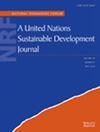模拟气候变化、甲烷排放和土地利用与伊朗畜牧业生产之间的联系:粮食安全视角
IF 3.7
4区 社会学
Q2 ENVIRONMENTAL SCIENCES
引用次数: 0
摘要
畜牧生产部门在粮食安全和创收方面发挥着至关重要的作用,并且与环境有着不可否认的关系。与其他农业部门一样,畜牧业也面临着气候变化的巨大挑战。然而,鉴于其重要性,对这一问题的关注并不令人满意。因此,本研究的主要目的是评估气温变化、降水量、甲烷排放量、固定资本总额和土地使用对作为伊朗粮食安全指标的畜牧业生产指数的影响。建模使用了 1990 年至 2020 年的数据,采用了 NARDL 方法和格兰杰因果关系。结果表明,气温每上升 1%,牲畜产量(粮食安全)就会减少 8.06%,而气温每下降 1%,牲畜产量就会增加 3.85%。降雨量与粮食安全有直接关系;降雨量增加和减少 1%,牲畜产量分别增加和减少 0.8%和 1.02%。固定资本总额每增加 1%,粮食安全就会提高 0.47%,而每减少 1%,粮食安全就会降低 2.32%。从长期来看,甲烷的正向冲击与粮食安全之间的关系在统计上并不显著。然而,该变量的负向冲击会对粮食安全产生 7.5% 的积极影响。土地利用的负向变化会降低牲畜产量。格兰杰因果检验证明,CH4 排放与畜牧业生产之间存在双向因果关系。从产量到温度以及从土地利用到畜牧业生产之间存在单向因果关系。为减轻全球变暖对畜牧业生产的影响,可将基础设施战略投资、畜牧业小额保险以及向生产者宣传气候变化的后果和应对这一现象的解决方案视为有效的政策。本文章由计算机程序翻译,如有差异,请以英文原文为准。
Modeling the linkage between climate change, CH4 emissions, and land use with Iran's livestock production: A food security perspective
The livestock production sector plays a crucial role in food security and income generation and has an undeniable relationship with the environment. Like other agricultural sectors, it faces the significant challenge of climate change. However, the attention given to this issue has not been satisfactory given its importance. Thus, the primary aim of the current research is to assess the impact of temperature change, precipitation, CH4 emissions, gross fixed capital, and land use on the livestock production index as an indicator of food security in Iran. The modeling uses data from 1990 to 2020, employing the NARDL approach and Granger causality. The results show that a 1% increase in temperature can lead to an 8.06% decrease in livestock production (food security), while a 1% decline in temperature results in a 3.85% surge in livestock production. Precipitation has a direct relationship with food security; a 1% rise and drop in rainfall lead to an increase and reduction in livestock production by 0.8% and 1.02%, respectively. A 1% increase in gross fixed capital boosts food security by 0.47%, while a 1% decrease leads to a 2.32% reduction. A statistically insignificant relationship is seen between the positive CH4 shock and food security in the long run. However, the negative shock of this variable positively influences food security by 7.5%. Negative changes in land use will reduce livestock production. The Granger causality test proves a two‐way causal relationship between CH4 emissions and livestock production. A unidirectional causality is discovered from production to temperature and from land use to livestock production. To mitigate the impact of global warming on livestock production, strategic investments in infrastructure, livestock micro insurance, and informing producers about the consequences of climate change and solutions for addressing this phenomenon can be considered effective policies.
求助全文
通过发布文献求助,成功后即可免费获取论文全文。
去求助
来源期刊

Natural Resources Forum
环境科学-环境科学
CiteScore
6.10
自引率
0.00%
发文量
24
审稿时长
>36 weeks
期刊介绍:
Natural Resources Forum, a United Nations Sustainable Development Journal, focuses on international, multidisciplinary issues related to sustainable development, with an emphasis on developing countries. The journal seeks to address gaps in current knowledge and stimulate policy discussions on the most critical issues associated with the sustainable development agenda, by promoting research that integrates the social, economic, and environmental dimensions of sustainable development. Contributions that inform the global policy debate through pragmatic lessons learned from experience at the local, national, and global levels are encouraged.
The Journal considers articles written on all topics relevant to sustainable development. In addition, it dedicates series, issues and special sections to specific themes that are relevant to the current discussions of the United Nations Commission on Sustainable Development (CSD). Articles must be based on original research and must be relevant to policy-making.
Criteria for selection of submitted articles include:
1) Relevance and importance of the topic discussed to sustainable development in general, both in terms of policy impacts and gaps in current knowledge being addressed by the article;
2) Treatment of the topic that incorporates social, economic and environmental aspects of sustainable development, rather than focusing purely on sectoral and/or technical aspects;
3) Articles must contain original applied material drawn from concrete projects, policy implementation, or literature reviews; purely theoretical papers are not entertained.
 求助内容:
求助内容: 应助结果提醒方式:
应助结果提醒方式:


